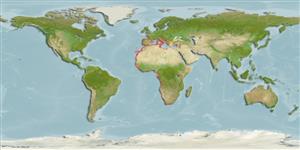Actinoptérygiens (poissons à nageoires rayonnées) >
Perciformes (Perch-likes) >
Sparidae (Porgies)
Etymology: Diplodus: Greek, diploos = twice + Greek, odous = teeth (Ref. 45335).
Environnement / Climat / Gamme
Écologie
; marin; saumâtre démersal; océanodrome (Ref. 51243); profondeur 0 - 50 m (Ref. 12460), usually 0 - 50 m (Ref. 13780). Subtropical, preferred 23°C (Ref. 107945); 48°N - 36°S, 18°W - 42°E
Eastern Atlantic: Mediterranean and Black Sea. Eastern Central Atlantic: Madeira Island (Ref. 74541).
Length at first maturity / Taille / Poids / Âge
Maturity: Lm ?, range 25 - ? cm
Max length : 45.0 cm TL mâle / non sexé; (Ref. 3397); common length : 22.0 cm TL mâle / non sexé; (Ref. 3397); poids max. publié: 1.9 kg (Ref. 40637); âge max. reporté: 10 années (Ref. 26328)
Épines dorsales (Total): 11 - 12; Rayons mous dorsaux (Total): 12-15; Épines anales 3; Rayons mous anaux: 11 - 14. Body with 5 black and 4 grey vertical bands. Snout is longer than the eye diameter (Ref. 35388).
Inhabits coastal rocky reef areas (Ref. 12460) and Posidonia oceanica beds. Like other sparids, it is very active and frequents the surf zone, primarily at dawn (Ref. 13780). Feeds on shellfish and other benthic invertebrates which it picks from the sediment (Ref. 5377).
Sexes separate or protandrous (Ref. 4781). In some areas, this species occurs as a digynic hermaphrodite, that is, males and females developing from intermediate juveniles (Ref. 52202). However, protandry with possible digyny was later confirmed (Ref. 103751). Reaches sexual maturity at 2 years, with an approximate size of 17 cm. Spawning happens from January to March. Egg size 0.8-0.9 mm; larval length at hatching 2.6 mm. Also Ref. 28504.
Bauchot, M.-L., 1987. Poissons osseux. p. 891-1421. In W. Fischer, M.L. Bauchot and M. Schneider (eds.) Fiches FAO d'identification pour les besoins de la pêche. (rev. 1). Méditerranée et mer Noire. Zone de pêche 37. Vol. II. Commission des Communautés Européennes and FAO, Rome. (Ref. 3397)
Statut dans la liste rouge de l'IUCN (Ref. 115185)
CITES (Ref. 94142)
Not Evaluated
Menace pour l'homme
Harmless
Utilisations par l'homme
Pêcheries: intérêt commercial mineur; Aquaculture: commercial; pêche sportive: oui
Outils
Articles particuliers
Télécharger en XML
Sources Internet
